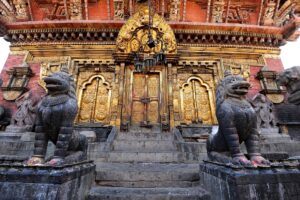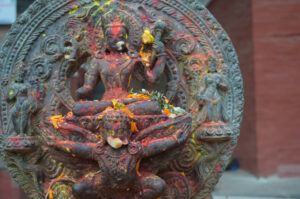
The Changu Narayan temple is the oldest Hindu temple in use in the Kathmandu valley, and is one of the seven structures that make the Kathmandu Valley a UNESCO World Heritage Site. The temple is dedicated to Lord Vishnu, the divine force of creation to Hindus, and it’s origins date back to the 4th century AD. The location of the temple on a hilltop just north of Bhaktapur makes the visit an excellent trip to escape the busy valley city life. The temple is very well described in the Nepal Guide Book.
You can combine your visit to the Changu Narayan temple with an outing to the nearby historical city of Bhaktapur or after an early morning trip to Nagarkot to enjoy the spectacular view over the Himalayan mountainrange from there (which is most clearly visible early in the morning).
Historical facts of the Changu Narayan Temple
The temple was initially built in the fourth century AD, which makes it the oldest Vishnu shrine in the Kathmandu Valley. As happens with many temples in the Himalayan region, it was destroyed and rebuilt several times due to earthquakes and fires. A major rebuilt took place in 1702 after a fire and more recently, major reconstruction was undertaken after the 2015 earthquake, when the temple was severly damaged.
The mythical story of the Changu Narayan Temple
The legend goes that Lord Vishnu mistakenly beheaded a Brahmim, who he thought to be a demon, when he was hunting in a forest. He was then cursed for the crime and wandered the earth on a Garuda and finally descended on Changu hill. Lord Vishnu lived there in anonymity, surviving on milk stolen from a cow that belonged to a sage called Sudarshan and was taken care of by a cow herder called Gwala. When Gwala noticed that the cow always went to the shade of a certain tree and a boy then descended to drink the milk, he alerted the sage Sudarshan to take action. Sudarshan cut down the tree and fresh human blood came out of it, which scared him off as he thought to have comitted a crime. Lord Vishnu then came from that tree and told them it was not their fault, and that he had mistakingly beheaded a Brahmin, Sudarshan’s father. Lord Vishnu was then liberated and freed from his sin. Brahmin and Gwala then decided to worship the place and built a small temple. The locality became a Holy Place since. It is believed that the curent priest of the temple is a descendant of Sudarshan, and the temple’s conservator a descendant of Gwala.
Exploring the Changu Narayan Temple
The temple is made in a pagoda style as a double storied building with roof struts with carved images of the 10 incarnations of Lord Vishnu as Narayan and various multi-armed Tantric goddesses. It is located on a large courtyard surrounded by sattals (rest houses). The temple has four doors, each guarded by sculptures of lions, griffins and elephants on each side of the entrances.

The courtyard surrounding the temple has a very rich selection of stone, wood and metal carvings as decorations. You will also find a beautiful selection of statues surrounding the temple.
In fact, the cultural development of the Kathmandu Valley over the years is reflected in the temple, as building and rebuilding work has been ongoing on this place since the fourth century. Additionally, you will find different shrines devoted to Shiva, Kali, Ganesh and Krishna within the courtyard.

You can see a Garuda figure near the west door, dating from the 5th century. The Garuda, a half-man and half-flying creature, served as Lord Vishnu’s vehicle. Near this statue you will find the oldest stone inscription in Sanskrit of the Kathmandu Valley, with a message of a king on how he convinced his mother not to commit (Sati) suicide after her husband had died.
The main image in the sacred place of the temple is worshipped by Hindus as the Garuda Narayan and by Buddhists as a Harihara Bahan Lokeshwara, and is only allowed to be ssen by the priest.
How to reach there?
You can reach Changu Narayan Temple by local bus, taxi or rented vehicle from Kathmandu, or by local bus from Bhaktapur (about 20 minutes ride). There are also trails from Bhaktapur (about 1.5 hours walk) and Nagarkot (4.5 hours via a resonably level unpaved road) to Changu Narayan, which gives you the opportunity to get acquinted with rural life in Nepal.
The site is also close enough to Kathmandu to reach by mountainbike.
The unique experience of a visit to the Changu Narayan Temple
A visit to the Changu Narayan temple is a must as you will experience a very rich heritage site in a beautiful setting with view over the valley, including the cities of Bhaktapur and Kathmandu. If the sky is clear, you can even have a view over the Himalaya range from here.
The site is of great cultural and religious importance as it is one of the few places that has survived since the fourth century, with significance for Hindus and Buddhists alike.
The temple is of great importance to learn about Nepal’s history and heritage. It’s idols and shrines are of rich architectural beauty, and this place learns us about different types of inscriptions on wood, metal and stone that are used in Nepal over time.
